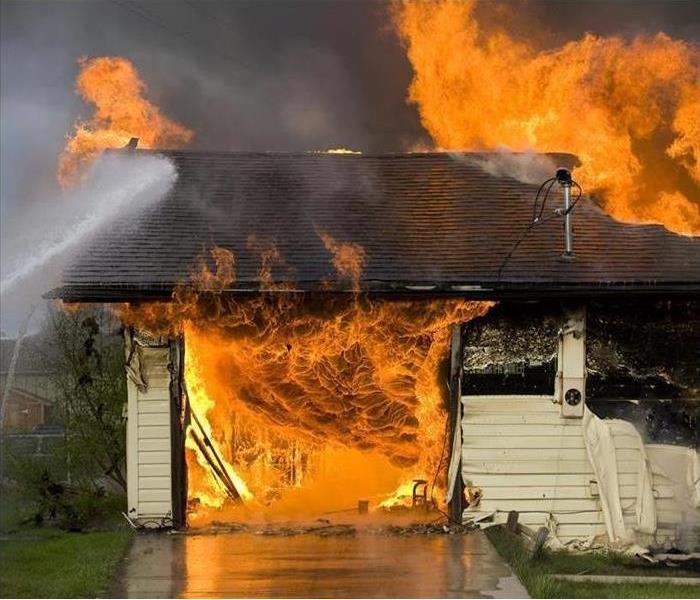What is the Best Way to Avoid a Fire in a Garage?
3/4/2022 (Permalink)
 SERVPRO has the experienced technicians with the equipment and expertise your home needs after a fire mishap. Give us a call right away.
SERVPRO has the experienced technicians with the equipment and expertise your home needs after a fire mishap. Give us a call right away.
SERVPRO Techs Have the Training and Equipment to Help Local Belmont Properties Recover From Damage to Their Property and Contents.
After a fire in your Belmont garage, it can be disheartening to see the amount of cleanup needed to use the space again. Unlike most fire restoration jobs, this is one type where the property owners can frequently remain on-site during the cleanup. This is because usually, there are no vents from the house leading into the garage, so there is no chance for the soot to spread into the ductwork of the home. For attached garages, as long as containment measures get applied to the entrance from the house's interior to the garage, the most potential for cross-contamination gets avoided. Organization in your garage is one of the best ways to prevent a fire, using methods such as:
- Shelving to keep clutter to a minimum
- Never storing flammable chemicals in the vicinity of anything electrical or with the potential to spark
- Keeping gas cans with fumes out of the area
- Ensuring outlets are not overloaded
- Keeping products with VOCs out of the closed environment of the garage
What is the Process for Handling Stubborn Fire Damage Residues?
Once the charred items get removed from the site with fire damage in a Belmont home, SERVPRO technicians work on cleaning the surfaces in the house. Attention to the surface is as essential as the type of smoke damage being removed. The techs carefully test surfaces to ensure the chosen removal method has no adverse effect on the article getting cleaned. Just as some surfaces can get damaged by using water, others can deteriorate after exposure to certain solvents. The three critical steps in using solvents to dissolve residues are:
- Wash the surface with the solvent; this action suspends the particles
- Rinse the surface from both solvent and smoke residues being careful about the disposal
- Dry the surface
This type of cleaning brings the community and environment responsibilities for safe disposal of the cleaning solvents used in this type of fire and smoke damage removal. SERVPRO techs are always careful to adhere to local, state, and federal regulations. Some of the main rules are:
- The solvents can never get disposed of within the sewer or septic system as the dry-cleaning solvents, in particular, is an industrial waste product.
- Also, the cleaning wastes should never get disposed of in storm drains or gutters.
- Wastewater used in cleaning that does not contain solvents can get disposed of through a treated sewer line, toilet, or utility sink.
What are Other Methods for Removal of Soot?
After SERVPRO techs handle the restoration services for damage from a fire in a garage, this can include a large amount of controlled demolition resulting in removing the sheetrock and insulation if present. Whenever stubborn smoke residues remain, there are other methods besides liquid cleaning solutions to remove them from the surfaces, particularly on the wood framework. The techs have access to high-powered equipment to perform abatement; one of the most popular is soda blasting. This uses sodium bicarbonate (yes, baking soda) delivered at a high velocity to remove any soot still adhering. Another tactic that gets used in the same fashion uses ice pellets. The removed material that gets extracted gets picked up using hand vacuums to ensure all residues are removed.
Prepping for rebuilding is a must during the restoration services. Before repairs or reconstruction can occur on a fire-damaged garage or any other part of the home, the worksite must be free of soot, charred materials, and smoke odors.
The odor control phase of the restoration services can take many forms. The technicians frequently need to take a multi-layered approach to ensure there are no signs of the previous fire that occurred. The techs use air scrubbers to improve air quality during the mitigation process, along with the detailed hand cleaning that techs perform, specialized equipment assists in the permanent removal of pungent fire odors. Two of the most typically seen tactics involve thermal fogging for eradicating embedded odors present and the use of hydroxyl generators to remove airborne particulate and neutralize it at the molecular level.
SERVPRO of The Lakes Region at (603) 527-2518 is the premier choice for fire damage restoration, no matter where the fire occurred or how widespread the damage is within your property. The trained, certified techs bring the know-how and expertise along with state-of-the-art equipment to make the home disaster "Like it never even happened."






 24/7 Emergency Service
24/7 Emergency Service